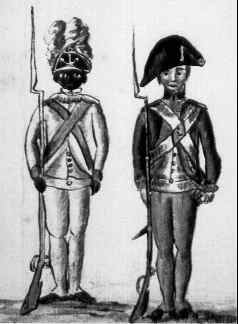African Americans in the Revolutionary War facts for kids
During the American Revolution, many African Americans played a big part. About 20,000 joined the British side. They were called Black Loyalists. Around 9,000 joined the American side. These were known as Black Patriots. Some of these brave people were already free. Others were enslaved and were promised their freedom if they fought.
Contents
- African-American Patriots: Fighting for Freedom
- African-American Loyalists: Joining the British
- African-American Sailors: On the Water
- The Black Regiment of Rhode Island
- What Happened to Black Loyalists?
- What Happened to Black Patriots?
- Quick Facts About African Americans in the Revolutionary War
- See Also
African-American Patriots: Fighting for Freedom
Many free African Americans wanted the American colonies to be independent from England. They became known as Black Patriots. One famous Patriot was Crispus Attucks. He is thought to be the first person killed in the Boston Massacre.
Some black men had already joined groups called Minutemen. These groups were ready to fight if British troops in Boston attacked the colonies. Both free and enslaved African Americans had also served in local groups. These groups defended themselves against attacks by Native Americans.
Black men fought with the American Patriot forces from the very start. They were at the Battles of Lexington and Concord, which began the Revolutionary War. African-American soldiers also fought in other important battles. These include the Battle of Bunker Hill and the Siege of Yorktown.
African-American Loyalists: Joining the British
About 20,000 African Americans fought for the British army. Most of these men did not fight in the northern parts of the colonies. However, when the British needed more soldiers, they used black men to fight in the South. This happened in places like Savannah, Augusta, and Charleston.
Lord Dunmore was the British governor of Virginia. He promised freedom to enslaved people who would fight for Britain. The enslaved people who joined the British side had "Liberty to Slaves" sewn onto their uniforms. They became known as Black Loyalists.
African-American Sailors: On the Water
Some African Americans chose to serve in the navies. Even in the Southern colonies, where people were against giving guns to enslaved people, black men helped. They piloted ships and used weapons on them. Some African Americans even became captains of ships.
The Black Regiment of Rhode Island
In 1778, Rhode Island needed more soldiers. They decided to try enlisting black men. The Rhode Island Assembly voted to allow this. The 1st Rhode Island Regiment became special. It was the only regiment in the Continental Army made up mostly of black soldiers.
What Happened to Black Loyalists?
After the last British ship left Savannah, many enslaved African Americans left too. About 5,000 traveled with their Loyalist owners to Jamaica or St. Augustine. Around 300 black people in Savannah stayed. They were afraid they would not get the freedom they were promised.
The British left Charleston a year later. They took more than 5,000 black men with them. More than half of these men were still enslaved by Loyalists. Some were given land.
In the North, the British created a special book. It listed people who had escaped slavery and was called the Book of Negroes. The book described their slavery, their escape, and their service to the British. If the British agreed that the person had helped Britain enough, they received a certificate. This certificate allowed them to travel out of New York. Many black men, women, and children then moved to Nova Scotia, Canada.
About 200 formerly enslaved people went to London to live as free people. People in England who supported freedom for black people started a colony in West Africa for them. Freetown was the first settlement there. It became part of the colony of Sierra Leone. Many people from Canada also moved to West Africa.
What Happened to Black Patriots?
The African American Patriots who fought in the Continental Army did not always get rewards after the war. Many states made laws that stopped all black people, free or enslaved, from serving in the military. However, North Carolina was one state that allowed free people of color to serve in their militias and carry weapons. In 1792, the United States Congress said that only "free able-bodied white male citizens" could serve in the military.
In 1789, free black men could vote in five of the thirteen states. This showed they were seen as citizens of their states and the United States.
Many enslaved men who fought in the war did gain their freedom. But some owners broke their promises. They forced the men to become enslaved again.
Within 20 years after the American Revolution, the Northern states ended slavery. By 1840, almost all African Americans in the North were free. However, the South kept slavery. They held onto it until the 13th Amendment to the United States Constitution was approved in December 1865.
Quick Facts About African Americans in the Revolutionary War
- African-American men who fought for the American colonies were called Black Patriots.
- African-American men who fought for the British were called Black Loyalists.
- The 1st Rhode Island Regiment was mostly made up of black soldiers.
- Both Black Patriots and Black Loyalists were promised their freedom if they fought in the war.
- After the war, some Patriots and Loyalists became free and settled in new places. Others were taken back by their former owners, who broke their promises.
- African Americans were no longer allowed to be enslaved when the 13th Amendment to the United States Constitution was ratified in December 1865.
See Also



